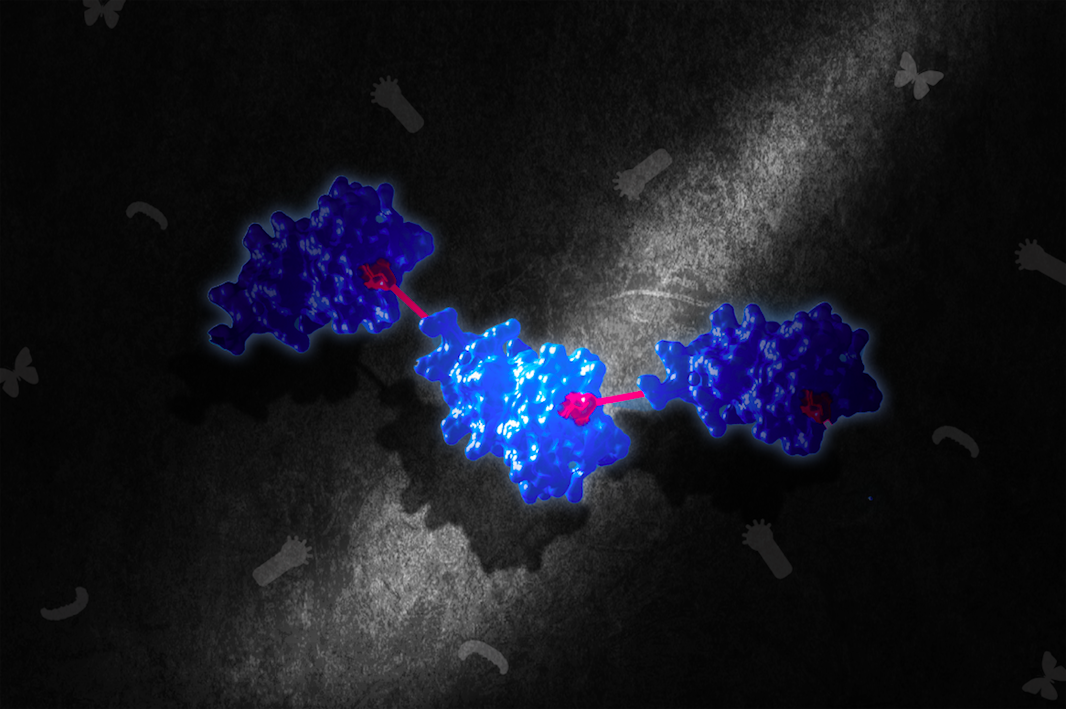Proteins often use Ubiquitin tags to be shuttled within cells or dispatched for degradation. Although small in demeanor, Ubiquitins are hugely influential. Hence they are a popular access point exploited by viruses to hijack their hosts.
A time-honored approach that viruses employ is to hitchhike onto the host’s Ubiquitin pathway or mimic these proteins. However, members of the Baculoviridae family of viruses (those infect insects) have been found to encode their own copy of Ubiquitin-like proteins (vUb). What makes the vUb worthy of a place in the viruses’s rather precious and skimpy genome? How is it structurally different from the eukaryotic Ubiquitins and what role does it play in penetrating the host?
A collaborative effort by Dr. Ranabir Das’s group (NCBS) and Dr. Sunil Laxman’s group (inStem) may have the answers.
In a recent study, Das and his team show that the viral Ubiquitin from baculoviruses harbors a novel amino acid - Lysine-54 (K54) that can form a unique chain of ubiquitin molecules. By earmarking proteins with such an unorthodox ‘K54-polyubiquitin’ tag, the virus makes them rather indiscernible by the host DeUbiquitinases (enzymes that cleave Ubiquitin, DUBs). The researchers speculate that this profitable K54 add-on in vUb might help viruses insulate their proteins from host antiviral responses.
“Among the wide variety of viruses studied so far, baculoviruses exclusively encode for a gene that mimics the central player Ubiquitin. The viral Ubiquitin originated from horizontal gene transfer, but its persistence indicates that its functions are distinct from the host Ubiquitin. We wanted to compare the structure, stability, and activity of viral Ubiquitin and host Ubiquitin,” elaborates Das on their motivation.
Firstly, through sequence analysis, the authors identified that Ubiquitin-like molecules are quite commonplace in the genomes of several viruses belonging to the Alphabaculovirus genera. In fact, the vUb and host Ubs are almost 75% similar to each other based solely on their genetic sequence information.
“What took us by surprise was that, despite such high sequence identity, vUB showed less stability compared to its homologous host Ub. This was rather puzzling and drove us to solve its structure,” explains Hitendra Negi, a graduate student from Das’s lab and lead author of the study.
A technique called Nuclear Magnetic Resonance (NMR) used to analyze the 3D structure of proteins revealed that the viral and host Ubiquitins have subtle differences in the way they fold onto themselves and the chemical bridges that they form. In addition, one major characteristic distinguishes vUb from the eukaryotic version - an extra Lysine residue at the 54th position (K54), which is native only to the viral protein.
“Lysines are important residues in Ubiquitin biology,” says Hitendra. This is because lysines help fasten Ubiquitin to proteins.
“The host Ubiquitins create polymeric chains linked via seven lysine amino acids present in their sequence,” elaborates Das. “Viral Ubiquitin however have this additional lysine. Since the chain structures vary depending on the linkage, we wanted to investigate the possibility and importance of a novel linkage through this additional lysine.”
Experiments revealed that vUb in fact makes use of the K54 residue to latch on to proteins. But are they identified in cells? This was by far the most important question to be answered because a protein’s fate is determined by the lysine residue through which it hooks onto Ubiquitin. For example, Ubiquitin tags through particular lysines (K11 and K48) are identified by enzyme complexes known as proteasomes and directed for destruction.
“A fruitful collaboration with Dr. Sunil Laxman’s lab helped us answer this key question. They had the perfect model organism – yeast, which could be used to address the issue,” says Hitendra.
It turns out that the protein with K54 linked vUb tags signal to the proteasomal degradation pathway. Interestingly, the K54 linked vUb-protein conjugates are resistant to deubiquitinases of the host. Deubiquitinases (DUB) are enzymes that identify and cleave ubiquitin links on proteins. Since the host DUB can no longer recognize such an atypical K54 tag, the authors speculate that this could be an excellent means of tricking the host and thus shielding the virus from antiviral reactions.
“This study is exciting because it uncovers a unique mechanism that protects the viral Ubiquitin signaling from host antiviral responses. It highlights the new complexities of Ubiquitin signaling and the importance of sequence divergence of viral Ubiquitin from the host Ubiquitin,” concludes Das. He feels that such studies that improve our understanding of the baculovirus life cycle will have implications in virology, biocontrol, and biotechnology.









0 Comments